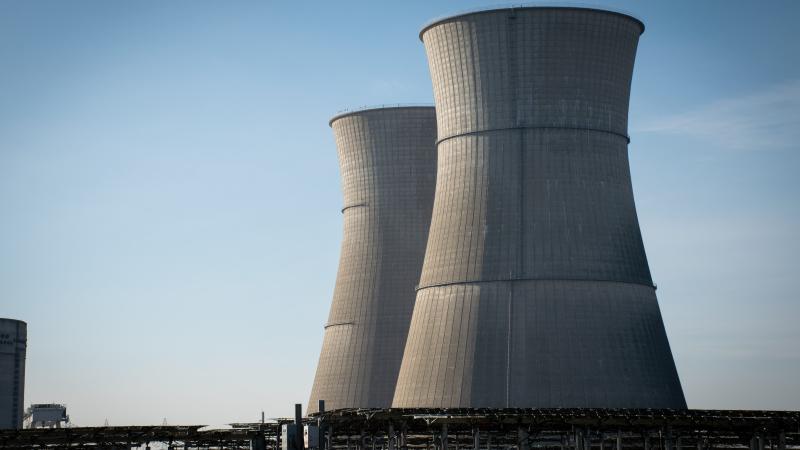DOE grants support research aimed at expanding clean energy options
August 5, 2021

Nuclear power plants produce about 20% of the United States’ electricity. In order to increase the amount of carbon dioxide-free energy these plants can yield, improvements in efficiency and safety must be made. With support from $1.5 million in grants from the Department of Energy (DOE), researchers at Rensselaer Polytechnic Institute will lead projects aimed at upgrading nuclear power plants with those goals in mind. The grants are part of more than $61 million in awards recently announced by the DOE to support nuclear energy research.
Light water reactors (LWR) are a common type of nuclear reactor. They produce heat when a fission reaction happens within the reactor’s core. Water that acts as a reactor coolant or a heat transfer fluid can be heated to become steam, which drives turbines that generate power. If light water reactors could be connected to chemical industrial plants, a portion of the steam generated in the reactor could be used to provide thermal energy — saving money and increasing efficiency.
“We aim to develop a new way to connect a nuclear power plant and a chemical plant, like a hydrogen plant,” said Shanbin Shi, an assistant professor of mechanical, aerospace, and nuclear engineering at Rensselaer, who is leading one of the DOE-supported projects.
Shi and his team will assess the current mechanisms at work in both a boiling water reactor — a type of LWR — and a hydrogen chemical plant. They will then design an energy extraction system and control algorithms capable of integrating the two plants, monitoring their functions, and controlling their processes. In order to test these control algorithms, researchers will also simulate different operating modes to determine if their integration design is safe, and to ensure it won’t have an impact on nuclear power plant operations. The Rensselaer team will collaborate with researchers from The Ohio State University, the University of Pittsburgh, Idaho National Laboratory, and GSE Performance Solutions Inc.
The results of this research, Shi said, will also benefit future nuclear engineers.
“We are training our students on how to operate advanced energy systems by combining commercial LWRs and chemical plants,” he said.
In another Rensselaer project supported by the DOE, Wei Ji, an associate professor of nuclear engineering, will advance future commercial reactor designs — like molten salt reactors or sodium fast reactors — by developing computational methods for quickly assessing the safety of these new reactor systems.
When fission happens inside a nuclear reactor, trace amounts of radioactive isotopes — known as fission products — may leak out of the core into the coolant loop, through which molten salt or sodium flows in order to capture heat from the reaction that can then be converted into energy. The transport and deposit of these radioactive isotopes within the coolant loop could affect the overall safe operation of the reactor, and must be either accounted for or captured, using special types of filters.
The Rensselaer team will collaborate with Argonne National Laboratory, which is developing a tool, known as the System Analysis Module (SAM) code. The SAM code is a simulation instrument capable of analyzing the thermal dynamics within various advanced reactor designs — from temperature to pressure to energy loss — and how reactors may operate under a number of conditions including accident scenarios. It’s an important instrument for assessing safety, but it could be improved if researchers better understood how different materials within the reactor may impact the overall system. For instance, deposits of radioactive material, corrosion, or a vent failure may affect how the overall reactor performs.
“Our role is filling that gap,” Ji said. “We need to know where the radioactive isotopes are, where they accumulate, because we don’t want radiation throughout the whole energy system.”
Ji and his team will model various chemical interactions so that they can add information about where deposits or material destruction may happen to the SAM code. These additions will help the industry design and evaluate safer systems.
“Based on the analysis assessment, they can do better mitigation design and develop techniques for how to clean up radioactive sources and fission products that are troublemakers in the system,” Ji said.
In addition to the Rensselaer-led projects, Jie Lian, a professor of mechanical, aerospace, and nuclear engineering at Rensselaer, will collaborate on a University of Pittsburgh-led effort to provide data, analysis, and modeling related to mechanical and thermal energy transport from high burnup doped fuels — research necessary for designing safer reactor systems.
In order to use these fuels, known as accident tolerant fuels, researchers need to understand how they fragment, disperse, and relocate under normal and abnormal conditions, and how heat can effectively be transferred out. This research will fill the current knowledge gap by combining advanced experimental, performance, and safety modeling and simulation tools necessary for future reactor testing.